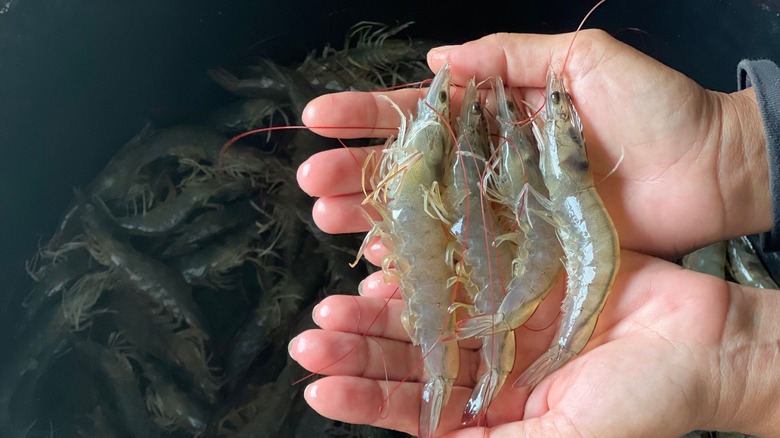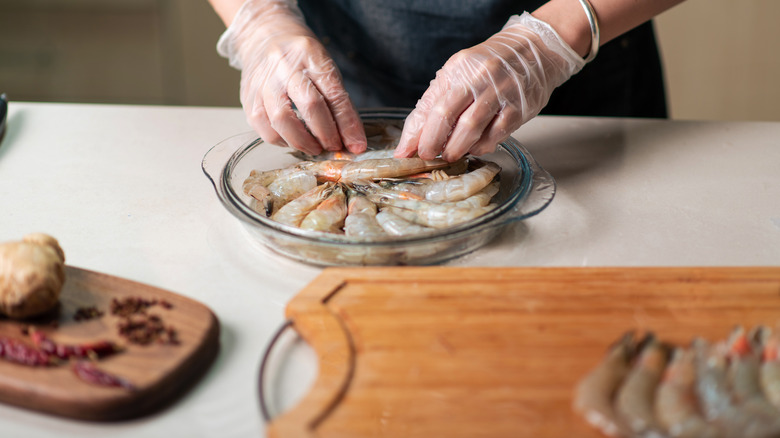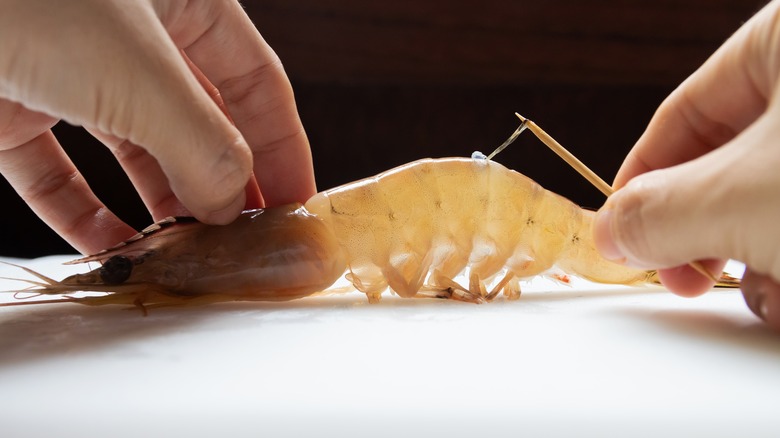A Fork Is All You Need To Easily Peel Shrimp
Shrimp is a delicious crustacean that brings great texture, flavor, and nutrients like protein, phosphorous, and potassium to a wide variety of dishes. But, if you're preparing them at home, they can be a bit more of a challenge than other proteins like chicken or beef. Depending on how you buy shrimp, its head, tail, up to 10 legs, and exterior shell may need to be removed — not to mention the delicate process of deveining them.
Since you pay more and often lose good meat with pre-cleaned shrimp, it's never worth the convenience to choose that option over shell-on. No matter how many parts you may need to nix before starting to cook, the process is easier than you may think — and you probably have a full set of the perfect tool to tackle the job already in your silverware drawer: a simple fork. Using one of the outer tines of the utensil, you can swiftly remove the shrimp shell in a single movement. Once you do, you'll be able to easily devein the shrimp, as well, leaving you ready to proceed with whatever dish you're making.
How to easily remove shrimp shells and devein them, too
Using your hands alone, peeling shrimp can be a tedious task — pulling off the head, then tugging off the legs, and picking off fragments of shell as carefully as you can to make sure nothing is left behind. But, by using a fork, all of this is done in one quick move. Just insert one of the outer tines on a fork into the shrimp's shell where its head used to be, then push it towards the tail end.
The fork works something like a letter opener, forcing the shell to break open along the animal's back and making it super easy to peel off in one piece, pinching off at the bottom to take the legs along with it. Plus, once the shell is off, you'll notice the fork has left a small incision along the back of the shrimp. Give it a quick rinse under cold water and you'll effortlessly devein the shellfish, too!
This process also works well with prawns, which differ from shrimp in size as well as structure, overall shape, and natural habitat. But, these larger varieties may require a bit more force to peel. Rather than a single push with the fork, you'll need to use a few sharper, shorter jabs to cut through thicker shells.
Is deveining shrimp essential?
The vein of a shrimp isn't unsafe to eat if fully cooked, but removing it is always a good idea. While it's called a vein, that's a bit of a misnomer. The black line that runs down the back of a shrimp is technically its digestive tract — which means the stuff inside it is waste, not blood. Though not harmful to consume, the vein can have a gritty texture and a bitter flavor. Since this fork peeling method makes deveining shrimp easy too, it's best to just remove this part and avoid any potential unpleasantness in your dish.
Plus, if you're using shrimp in something like a ceviche, where citric acid breaks down the protein in a similar way to cooking with heat, the vein must be removed since, with too little lime juice or insufficient marinating time, bacteria inside the intestine can stay alive and cause food poisoning (per a 2022 study in Foods).
Depending on the size and variety of your shrimp, you may also see a black line running down the belly side. Don't feel like you need to do any additional cutting and rinsing to remove this — it's a nerve bundle, not another intestine. While you may prefer to remove it, these nerves have no taste or texture, so they aren't going to disrupt your meal.



